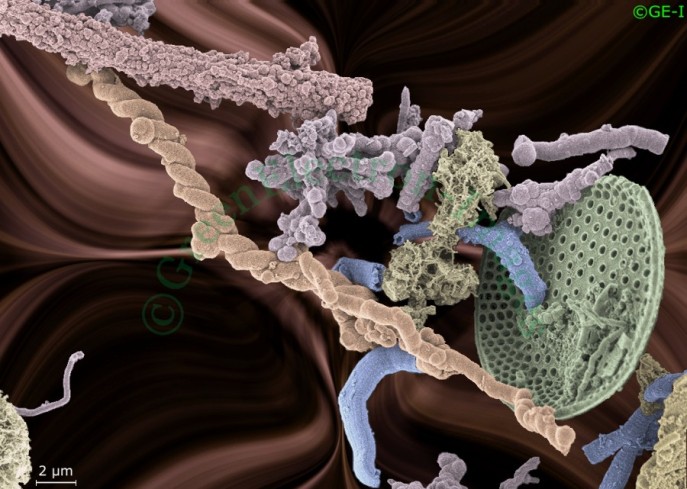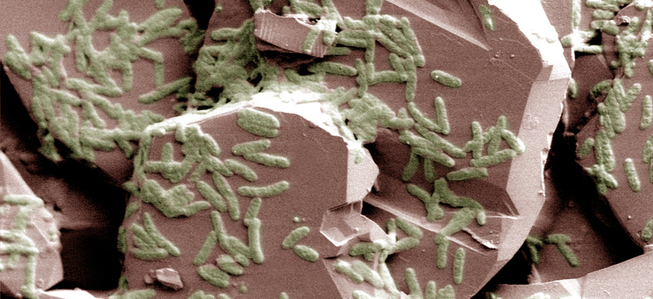
Scanning electron image of mineralized bacteria from a deep sea hydrothermal vent known as a “black smoker”. Microbes living in extreme subterranean environments such as this may be more abundant than once thought. Credit : SEM Images
Microbes in the deep biosphere – ocean floor sediments, subterranean aquifers, the continental crust – often get the short end of the research stick. Reproducing every few thousand years and living in perpetual starvation, life far beneath the surface beats to a different drum. The strangeness of life down deep presents numerous challenges to researchers. Getting uncontaminated samples is difficult and expensive, but once they’re back in the lab, inducing “zombie bacteria” to grow is another hurdle entirely.
Given the trouble involved, is it even worth studying the deep biosphere?
Perhaps a different way of framing that question is to ask how much the deep biosphere matters to the rest of the world. Is it simply a collection of curious survivalists, biologically impressive but of little importance to life on the surface? Or is the deep biosphere large enough that we can’t just shrug it off as too remote?
In a paper recently published in the journal FEMS Microbiology Ecology, Dr. Sean McMahon seeks to answer this question using a simple approach. How much, McMahon asks, does the deep continental biosphere weigh?
Ecosystem-scale biomass (or carbon) measurements are used to inform everything from agricultural and land management decisions to climate negotiations. But getting the numbers right is not a trivial problem. A certain amount of assuming, averaging, and extrapolating is always needed. While imperfect, such numbers carry immense value. Estimating the carbon stored in the deep continental biosphere allows scientists to evaluate the importance of subterranean bacteria on a global scale.
To determine the microbial carbon stored in the continental crust, McMahon compiled 120 cell density measurements from aquifers located anywhere from 10 meters to 3.6 km down. He also collected information on the volume of groundwater and its distribution throughout the crust, which he used to estimate the total number of cells present in groundwater worldwide.
McMahon’s groundwater data only represented “unattached” cells. Attachment to mineral particles allows bacteria to form protective biofilms and maintain a relatively stable environment. In aquifers, attached bacteria outnumber free-floaters anywhere from 100 to 1,000-fold. So McMahon scaled up his estimate accordingly. Finally, McMahon assumed that each bacterial cell in the subsurface contains 26 femtograms (10^-15 grams!) of carbon. While the carbon content of a bacteria is highly variable, ranging from 10 – 100 fg, McMahon created a low-end estimate for the weight of an average bacteria living in starvation conditions.
From all this information, McMahon estimates there are 14 – 135 petagrams of microbial carbon in the continental crust. (1 Pg = 10^15 grams). On the low end, this is approximately twice the amount of carbon that enters our atmosphere every year due to fossil fuel burning. On the high end, it’s roughly equivalent to the total annual carbon dioxide respired by vegetation and soils worldwide.
McMahon’s estimate is probably conservative. Most of his data is from aquifers bearing relatively large sand particles that serve as microbial attachment sites. Sediments consisting of smaller, clay-sized particles have larger surface areas and are likely to host more attached bacteria. McMahon also excluded coal and hydrocarbon deposits from his estimates. But these are energy-rich environments where bacteria are probably far more abundant.
Ultimately, by producing an estimate of microbial carbon stored in the crust, McMahon is able to affirm the deep biosphere’s global significance. Taken together with new research demonstrating the role subsurface microbes play in rock weathering and nutrient cycling, perhaps the larger take home is that we should start paying a little more attention to the bacteria miles beneath our feet.
An excellent overview of life in the deep biosphere.
McMahon S, & Parnell J (2014). Weighing the deep continental biosphere. FEMS microbiology ecology, 87 (1), 113-20 PMID: 23991863
